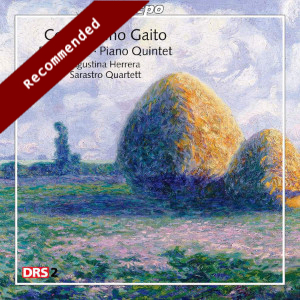
Constantino Gaito (1878-1945)
Piano Trio, Op. 25 (1917)
Cello Sonata, Op. 26 (1918)
Piano Quintet, Op. 24 (1917)
Agustina Herrera (piano)
Sarastro Quartett
rec. 2009, Zurich, Switzerland
cpo 777 514-2 [56]
cpo are renowned for their championing of rare repertoire by relatively unknown composers. Constantino Gaito is such a case in point.
He was born in Buenos Aires in 1878. His father was a musician and sent Constantino to Naples to study. Here the boy came under the influence of such composers as Busoni, Saint-Saens, Massenet and even the renowned conductor Arturo Toscanini. On his return to Argentina he helped found the national opera and worked as a multi talented composer, conductor and pianist. He composed opera, ballet, symphonic and chamber works.
The three chamber works featured here were all penned between 1916-18, and are firmly entrenched in the late Romantic style. It’s notable that the composer was an accomplished pianist, as the virtuosic piano writing in all three scores testify.
Each of these three movement works consists of outer allegro movements framing exquisite slow movements. The Quintet’s Andante movement is particularly ravishing, and I would recommend listening to this first as I cannot imagine it failing to encourage you to explore further. The violin dominates in the first part and the cello in the second. The movement ends hushed and reflective, and the players achieve this with great sensitivity, warmth and refinement.
What struck me in the opener of the Piano Trio, Op. 25, and indeed in all three first movements, is the romantic exuberance of the writing. Each is upbeat and passionate, yet there’s much contrast within. The Trio first movement has a more subdued section in the middle and ends quietly. Its slow movement is quiet, dark and marked by pathos. The third movement is spirited and joyous and calls time in exuberant fashion.
The Cello Sonata is a more serious affair and reveals a much greater advanced compositional style. I sensed a certain pathos and reflective quality in the slow movement. The piano assumes a major role in the finale where there’s some very florid pianistic writing.
For me, the Piano Quintet is the pièce de résistance. The first movement opens with an attractive, memorable and soaring melody. It presents as energetic, light and sunny, in contrast to the slow movement I’ve already discussed. It ends with three emphatic chords. The finale brings the work to a triumphant end.
The Sirastro Quartet, together with Augustina Herrera, play with great commitment and impeccable musicianship. The sound quality is excellent, and the booklet notes are comprehensive and informative.
Another winner from CPO. Highly recommended!
Stephen Greenbank
Previous review: Rob Barnett (August 2023)
Help us financially by purchasing from



















